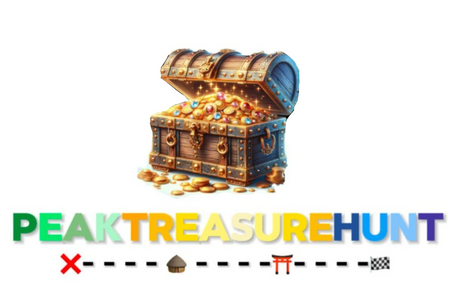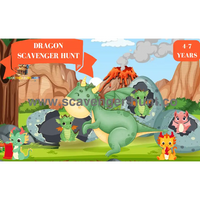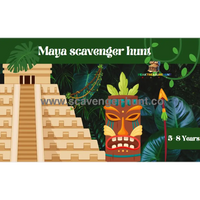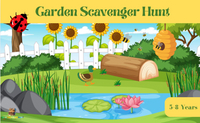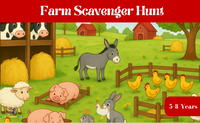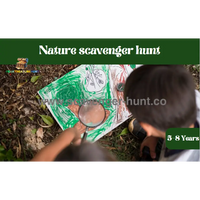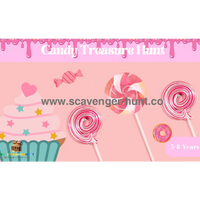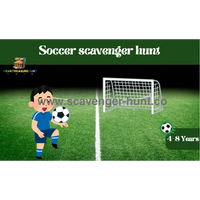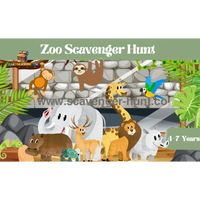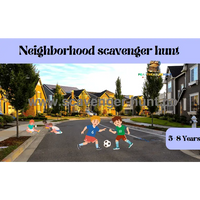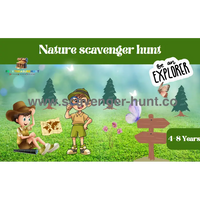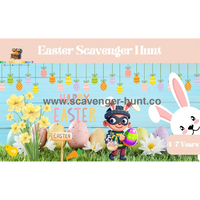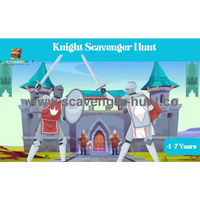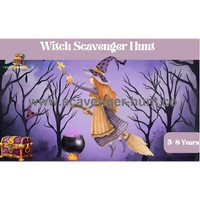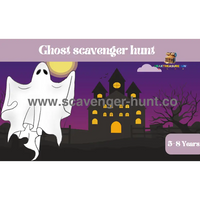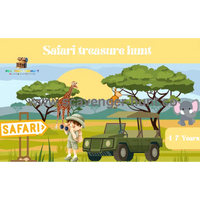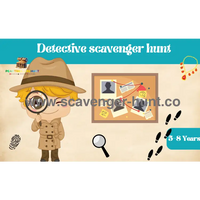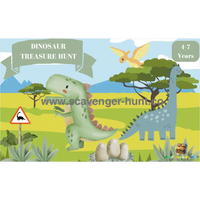Turn Your Garden Into an Adventure: The Ultimate Guide to Garden Scavenger Hunts
Gardens are magical places where nature comes alive, but they can become even more enchanting when transformed into treasure-hunting grounds. A garden scavenger hunt combines the joy of exploration with hands-on learning, making it perfect for families, educators, birthday parties, or anyone looking to add excitement to outdoor time.
Whether you're working with a small backyard herb garden or sprawling botanical paradise, creating a memorable scavenger hunt experience is easier than you might think. This comprehensive guide will walk you through everything you need to know to design, organize, and execute the perfect garden adventure.
Why Garden Scavenger Hunts Are Perfect for Everyone
Garden scavenger hunts offer unique benefits that indoor activities simply can't match. Participants develop observational skills while learning about plants, insects, and ecosystems. Children naturally become more curious about nature when they're actively searching for specific items rather than passively walking through garden spaces.
These outdoor adventures also encourage physical activity without feeling like exercise. Hunters climb, bend, reach, and explore every corner of the garden space. The fresh air and sunshine provide natural mood boosters while participants work together to solve clues and find hidden treasures.
For educators and parents, garden hunts create teachable moments organically. Conversations about plant life cycles, seasonal changes, pollination, and garden maintenance emerge naturally as hunters discover different elements. These experiences stick with participants long after the hunt ends.

Planning Your Garden Scavenger Hunt
Successful garden hunts require thoughtful preparation that considers your specific space, participants, and goals. Start by walking through your garden with fresh eyes, noting interesting features, seasonal highlights, and potential hiding spots that others might overlook.
Consider your participants when designing the difficulty level. Young children enjoy finding obvious items like red flowers or smooth stones, while teenagers and adults appreciate more challenging clues that require problem-solving skills. Mixed-age groups work well when you include both simple observations and complex puzzles.
Time management is crucial for maintaining engagement. Most garden hunts work best when lasting between 30-60 minutes, depending on the group size and garden complexity. Too short feels rushed, while too long can lead to fatigue and frustration, especially with younger participants.
Weather considerations should influence your planning timeline. Spring and fall often provide ideal conditions with moderate temperatures and interesting seasonal changes. Summer hunts work well in early morning or evening when heat is less intense. Even winter gardens can offer unique hunting opportunities with evergreen plants, winter birds, and frost patterns.
Creative Hunt Ideas for Every Season
Spring Garden Adventures
Spring gardens burst with new growth and returning wildlife, creating perfect scavenger hunt conditions. Participants can search for emerging bulbs, count different types of tree buds, or locate the first flowering plants of the season. Bird nests, blooming fruit trees, and fresh green shoots provide excellent hunting targets.
Create clues around spring garden tasks like finding where seeds have been planted or identifying which plants survived winter. Challenge hunters to locate evidence of garden cleanup or preparation for the growing season. Spring hunts work especially well for teaching about plant life cycles and seasonal garden care.
Summer Exploration Theme
Summer gardens offer abundant hunting opportunities with peak growing seasons and maximum wildlife activity. Participants can search for different flower colors, count types of pollinators, or find various stages of fruit development. Vegetable gardens provide opportunities to locate different growth stages from seedlings to harvest-ready produce.
Water features become focal points during hot weather, so incorporate fountain areas, bird baths, or irrigation systems into your hunt. Challenge participants to find natural cooling spots like shaded seating areas or plants that provide natural air conditioning through transpiration.
Autumn Discovery Mission
Fall gardens showcase dramatic changes that create engaging scavenger hunt elements. Participants can collect different leaf shapes, find seeds ready for harvesting, or locate plants preparing for winter dormancy. Autumn cleanup activities provide hunting opportunities around compost areas, tool storage, or winter preparation tasks.
Seasonal decorations and harvest displays often appear in fall gardens, offering additional hunting targets. Challenge participants to find evidence of seasonal transitions like changing leaf colors, fruit ripening, or wildlife preparing for winter migration or hibernation.
Winter Wonder Hunts
Winter gardens might seem less active, but they offer unique scavenger hunt possibilities. Evergreen plants, winter berries, and plant structures become more visible without leafy coverage. Participants can search for winter bird feeding areas, identify trees by their bark patterns, or find plants that maintain color during cold months.
Ice formations, frost patterns, and snow-covered features create temporary hunting elements that change daily. Winter hunts often focus more on observation and identification skills rather than finding hidden objects, making them perfect for developing deeper nature appreciation.
Age-Appropriate Hunt Designs
Preschool Adventures (Ages 3-5
Very young children need simple, concrete hunting goals they can easily understand and accomplish. Focus on basic colors, shapes, and textures rather than complex plant identification. "Find something red," "locate a smooth stone," or "discover a leaf bigger than your hand" work well for this age group.
Use picture cards showing exactly what children should find rather than written clues. Keep groups small and provide plenty of adult guidance. Celebrate every discovery enthusiastically to maintain excitement and build confidence in outdoor exploration.
Elementary Explorations (Ages 6-10
School-age children can handle more complex instructions and enjoy solving simple puzzles. Combine observation tasks with basic learning objectives like counting, measuring, or categorizing. "Find three different leaf shapes" or "locate a plant taller than you are" challenge them appropriately.
Introduce basic plant and insect identification through picture guides or simple field books. Elementary-age participants enjoy working in small teams and appreciate having special roles like team leader, recorder, or navigator during the hunt.
Teen and Adult Challenges (Ages 11+)
Older participants appreciate hunts that challenge their problem-solving abilities and teach them something new. Use plant identification guides, create riddles about garden history, or incorporate horticultural knowledge into clues. "Find the plant that blooms only at night" or "locate evidence of beneficial insects at work" engage mature hunters.
Consider adding photography elements where participants document their findings or create nature art from collected materials. Competitive elements like timed sections or point systems can motivate older groups while maintaining the educational focus.
Essential Supplies and Materials
Basic Hunt Equipment
Every garden scavenger hunt needs certain fundamental supplies regardless of complexity level. Clipboards or sturdy backing boards help participants manage their hunting lists and record findings. Pencils work better than pens outdoors since they don't freeze, overheat, or run out of ink unexpectedly.
Collection bags or containers allow hunters to gather specimens, though always emphasize taking only what's appropriate and in small quantities. Small magnifying glasses help participants observe details they might otherwise miss. First aid supplies should always be accessible for minor scrapes or insect bites.
Weather-Specific Gear
Outdoor activities demand preparation for changing conditions. Sun hats, sunscreen, and water bottles are essential during warm weather hunts. Light jackets or sweatshirts provide comfort during cool morning or evening adventures. Rain ponchos or umbrellas can save hunts from unexpected weather changes.
Insect repellent becomes important during peak bug seasons, especially in gardens with water features or dense plantings. Consider providing hand sanitizer for after participants handle soil, plants, or garden materials during their exploration.
Documentation Tools
Cameras or smartphones allow participants to document discoveries without disturbing garden plants or wildlife. Some hunts work well with nature journals where participants sketch or describe their findings. Measuring tools like rulers or measuring tapes add precision to observation-based challenges.
Consider providing field guides or identification books relevant to your garden's plant and wildlife populations. Laminated reference sheets with common garden plants, insects, or birds help participants learn while they hunt.

Safety Considerations for Garden Adventures
Garden safety starts with clear boundary establishment and hazard identification. Walk through your hunting area beforehand to identify potential dangers like thorny plants, uneven pathways, or areas where participants shouldn't venture. Communicate these boundaries clearly before beginning the hunt.
Plant safety education is crucial since some garden plants can cause skin irritation or are toxic if consumed. Teach participants to look but not touch unfamiliar plants, and never to eat anything they find during the hunt. Provide clear guidelines about which plants are safe to handle and which should be observed from a distance.
Insect and wildlife encounters are part of garden exploration, but participants should understand basic safety protocols. Teach them to observe bees and wasps from a respectful distance, avoid disturbing bird nests or wildlife dens, and notify adults about any concerning discoveries like wasp nests or injured animals.
Tool safety becomes important if your hunt involves any garden implements. Even simple tools like hand pruners or small shovels require proper instruction and adult supervision. Consider whether tools are necessary for your hunt objectives or if observation-only activities would be safer and equally engaging.
Creating Engaging Clues and Challenges
Observation-Based Challenges
The best garden scavenger hunt clues encourage careful observation while teaching participants about their natural environment. Instead of simply asking hunters to find a red flower, challenge them to locate flowers that attract butterflies or identify plants that bloom at different times of day.
Sensory challenges engage multiple learning styles while keeping hunts interesting. Ask participants to find plants with different textures, identify flowers with distinct fragrances, or locate areas where they can hear different sounds like buzzing insects, rustling leaves, or flowing water.
Educational Integration
Garden hunts provide perfect opportunities to weave in learning objectives without feeling like formal education. Plant life cycle hunts can challenge participants to find seeds, seedlings, mature plants, and plants going to seed all in one garden exploration.
Ecosystem challenges help participants understand how garden elements work together. Ask hunters to find evidence of beneficial insects, locate plants that provide wildlife habitat, or identify examples of companion planting where different plants support each other's growth.
Puzzle and Riddle Elements
Word puzzles and riddles add intellectual challenge to physical exploration. Create rhyming clues that lead participants to specific garden locations, or develop crossword-style puzzles where answers can only be found by observing particular plants or garden features.
Mathematical challenges work well for school-age participants. Ask them to count flower petals, measure plant heights, or calculate areas of garden beds. These activities reinforce academic skills while maintaining the adventure atmosphere.
Tips for Successful Hunt Execution
Group Management Strategies
Successful garden hunts require thoughtful group organization from start to finish. Divide large groups into smaller teams of 4-6 participants to ensure everyone stays engaged and has opportunities to contribute. Mix ages and abilities when possible to encourage peer learning and cooperation.
Assign specific roles within each team to prevent conflicts and ensure participation. Designate team leaders, recorders, navigators, and safety monitors. Rotate these roles during longer hunts so everyone experiences different responsibilities and stays engaged throughout the activity.
Timing and Pacin
Begin hunts with clear instruction sessions that review safety rules, boundaries, and objectives. Allow time for questions and ensure everyone understands the format before beginning exploration. Consider starting with easier challenges to build confidence before progressing to more difficult tasks.
Monitor energy levels throughout the hunt and be prepared to adjust the timeline if participants seem tired or frustrated. Plan natural break points where teams can share discoveries, compare progress, or receive additional clues. End hunts while participants are still engaged rather than pushing through fatigue.
Celebrating Discoveries
Recognition and celebration are crucial elements of successful garden hunts. Create opportunities for teams to share their most interesting discoveries with the larger group. Consider awards for categories like "most creative solution," "best teamwork," or "most interesting observation" rather than focusing only on completion speed.
Document the experience through group photos or individual certificates that participants can take home as mementos. Some hunts work well with closing circles where everyone shares one thing they learned or found surprising during their garden exploration.
Seasonal Adaptations and Variations
Garden scavenger hunts can be adapted for any season with thoughtful planning and creative challenge design. Each season offers unique opportunities and requires specific considerations for maximum success and enjoyment.
Weather-Responsive Planning
Monitor weather forecasts closely and have backup plans for sudden changes. Indoor garden centers, greenhouses, or conservatories can provide alternative venues during severe weather while maintaining the garden theme. Some hunts can be modified for covered outdoor spaces like pavilions or gazebos.
Seasonal timing affects garden activity and wildlife behavior. Early morning hunts during summer months avoid peak heat while offering opportunities to observe morning-blooming flowers or active wildlife. Late afternoon winter hunts take advantage of available daylight while avoiding the coldest parts of the day.
Holiday and Special Event Themes
Holiday-themed garden hunts add festive elements to traditional formats. Halloween hunts can focus on orange and black plants, unusual plant shapes, or "spooky" garden elements like twisted branches or unusual seed pods. Spring Easter hunts naturally incorporate egg-shaped objects, baby plants, and renewal themes.
Educational holidays like Earth Day provide perfect opportunities for conservation-focused garden hunts that teach about sustainable gardening practices, native plants, or environmental stewardship. These themed hunts often resonate more deeply with participants than generic exploration activities.

Making the Most of Your Garden Space
Small Space Solution
Even tiny gardens can host engaging scavenger hunts with creative planning and design. Container gardens offer opportunities to focus on plant variety, growth stages, and care techniques. Vertical gardens, window boxes, and herb gardens provide concentrated hunting areas where every plant serves multiple purposes.
Consider expanding hunts beyond plant materials to include garden tools, decorative elements, or structural features like trellises, stakes, or plant labels. Small spaces often require more creativity in clue design but can offer more intimate, detailed exploration experiences.
Large Garden Strategies
Extensive gardens require careful zone planning to prevent participants from becoming overwhelmed or lost. Create maps showing hunt boundaries and major landmarks like pathways, water features, or significant trees. Consider progressive hunts where teams unlock new garden areas by completing challenges in previous sections.
Use garden focal points like sculptures, benches, or special plant collections as anchor points for clue placement. Large gardens offer opportunities for longer, more complex hunts that can include multiple themes or educational objectives within a single experience.
Ready-Made Hunt Solutions
Planning and creating garden scavenger hunts from scratch takes considerable time and effort, especially when trying to balance educational value with engaging entertainment. For those seeking professionally designed, ready-to-use solutions, our Scavenger Hunt In The Garden collection offers expertly crafted hunts that eliminate the planning stress while ensuring memorable outdoor experiences.
These professionally developed hunts include age-appropriate clues, safety guidelines, printable materials, and flexible formats that work in various garden settings. Whether you're an educator seeking curriculum-aligned outdoor activities, a parent planning a unique birthday celebration, or an organization developing team-building experiences, ready-made hunt packages provide tested, successful formats that engage participants while teaching them about the natural world.
Extending the Garden Hunt Experience
Garden scavenger hunts don't have to end when the last item is found. Extend the learning and excitement through follow-up activities that reinforce discoveries and encourage continued garden exploration.
Documentation and Reflection
Encourage participants to create nature journals documenting their hunt experiences and discoveries. Sketching, pressing flowers, or photographing findings helps cement memories while developing observation skills. Some participants enjoy creating field guides specific to your garden space that can be used for future hunts or general exploration.
Digital documentation through photos or videos allows participants to share their experiences with friends and family who couldn't attend. Consider creating group presentations or displays showcasing hunt discoveries and what participants learned about garden ecosystems.
Garden Adoption and Stewardshi
Transform hunt participants into garden stewards by assigning them specific plants or garden areas to monitor over time. This ongoing connection encourages regular garden visits and develops deeper understanding of seasonal changes, plant care requirements, and garden maintenance needs.
Involve hunt participants in garden improvement projects like planting, weeding, or habitat creation. These hands-on activities build on the exploration foundation established during scavenger hunts while teaching practical gardening skills and environmental responsibility.
Conclusion: Growing Connections Through Garden Adventures
Garden scavenger hunts represent more than simple outdoor entertainment. They create meaningful connections between people and the natural world while fostering curiosity, observation skills, and environmental awareness. Whether you're working with young children taking their first steps into nature education or adults seeking unique recreational experiences, garden hunts offer scalable, adaptable adventures that grow with your participants.
The magic of garden scavenger hunts lies in their ability to transform familiar outdoor spaces into discovery zones where every plant, insect, and garden feature becomes part of an engaging story. Participants leave these experiences with new knowledge, increased confidence in outdoor settings, and often a renewed appreciation for the natural world around them.
Start planning your garden scavenger hunt adventure today. Your garden is waiting to become the backdrop for memories that will last a lifetime, and the natural classroom where curiosity takes root and grows into lifelong learning.
